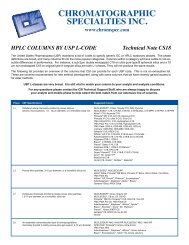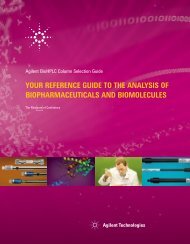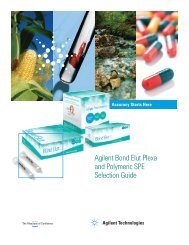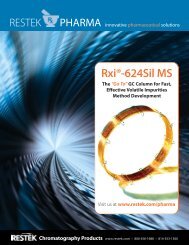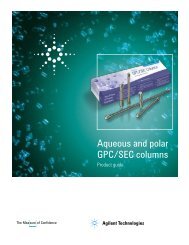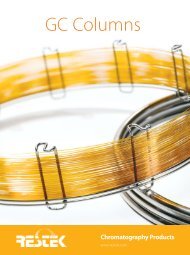Optimizing the Analysis of Volatile Organic Compounds
Optimizing the Analysis of Volatile Organic Compounds
Optimizing the Analysis of Volatile Organic Compounds
You also want an ePaper? Increase the reach of your titles
YUMPU automatically turns print PDFs into web optimized ePapers that Google loves.
1. chloromethane<br />
2. vinyl chloride<br />
3. bromomethane<br />
4. chloroethane<br />
5. trichlor<strong>of</strong>luoromethane<br />
6. 1,1-dichloroe<strong>the</strong>ne<br />
7. methylene chloride<br />
8. trans-1,2-dichloroe<strong>the</strong>ne<br />
9. 1,1-dichloroethane<br />
10. bromochloromethane<br />
11. chlor<strong>of</strong>orm<br />
12. carbon tetrachloride<br />
13. 1,1,1-trichloroethane<br />
14. benzene<br />
15. pentafluorobenzene (surr.)<br />
16. 1,2-dichloroethane<br />
17. fluorobenzene (surr.)<br />
18. trichloroe<strong>the</strong>ne<br />
19. 1,2-dichloropropane<br />
2<br />
1<br />
3<br />
5<br />
4<br />
Figure 51.<br />
Gaseous analytes resolved to baseline on an Rtx ® -VMS column.<br />
20. bromodichloromethane<br />
21. 2-chloroethyl vinyl e<strong>the</strong>r<br />
22. cis-1,3-dichloropropene<br />
23. toluene<br />
24. tetrachloroe<strong>the</strong>ne<br />
25. trans-1,3-dichloropropene<br />
26. 2-bromo-1-chloropropane<br />
27. 1,1,2-trichloroethane<br />
28. dibromochloromethane<br />
29. ethylbenzene<br />
30. chlorobenzene<br />
31. brom<strong>of</strong>orm<br />
32. 4-brom<strong>of</strong>luorobenzene (surr.)<br />
33. 1,4-dichlorobutane<br />
34. 1,1,2,2-tetrachloroethane<br />
35. 1,3-dichlorobenzene<br />
36. 1,4-dichlorobenzene<br />
37. 1,2-dichlorobenzene<br />
6<br />
8<br />
7<br />
9<br />
11<br />
12<br />
10<br />
13<br />
14<br />
15 17 18<br />
1.00 2.00 3.00 4.00 5.00 6.00 7.00 8.00 9.00 10.00 11.00 12.00 13.00 14.00 15.00<br />
30m, 0.25mm ID, 1.40 m Rtxfi-VMS (cat#19915)<br />
Conc.: 20 ppb in 5mL <strong>of</strong> RO water<br />
Concentrator: Tekmar LSC-3000 Purge and Trap<br />
Trap: Vocarb 3000 (type K)<br />
Purge: 11 min. @ 40mL/min. @ ambient temperature.<br />
Dry purge: 1 min. @ 40mL/min. (MCS bypassed using<br />
Silcosteelfi GC_EV00425<br />
GC Interface: 1:10 split at injection port. 1mm ID sleeve.<br />
GC: HP 6890<br />
Oven temp.: 40 C (hold 4 min.) to 95 C @ 24 C/min. (hold 3 min.), to<br />
210 C @ 40 C/min. (hold 6 min.)<br />
Carrier gas: helium @ ~1mL/min. constant flow<br />
Adjust dichlorodifluoromethane to a retention time <strong>of</strong><br />
tubing)<br />
2.54 min. @ 40 C<br />
Desorb preheat: 245 C<br />
Detector: HP 5973 MSD<br />
Desorb: 250 C for 2 min. , Flow 10mL/min.<br />
Scan range: 25-300amu<br />
Bake: 260 C for 8 min.<br />
16<br />
Method 624: Previously, analysts used packed columns to perform Method 624, but now <strong>the</strong>y generally use capillary chromatographic techniques.<br />
The compound list in Method 624 includes commonly analyzed aromatic and halogenated compounds in wastewater. This analysis<br />
can be achieved on many capillary columns; Figure 51 shows a 30m, 0.25mm ID Rtx ® -VMS column resolves <strong>the</strong> gaseous analytes to <strong>the</strong><br />
baseline.<br />
19<br />
20<br />
21 22<br />
23 24,25<br />
27<br />
26<br />
28<br />
29 30<br />
31<br />
36<br />
33,34 35<br />
32<br />
37<br />
55<br />
www.restekcorp.com





